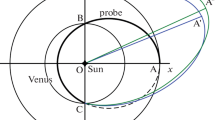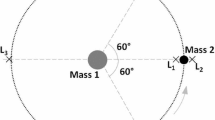Abstract
Against the background of insufficient information on the law of gravity in near space, a justification is proposed for conducting a high-precision artificial experiment to determine the law of gravity dominating the Solar System. It is proposed to use the Sun–Earth–Venus system, space probes, and observers as a “gravitational space laboratory.” The scheme of a “standard ballistic flight” is defined as a complex trajectory of the probe, comprising the Earth-Venus path, accelerating gravitational maneuver at Venus, and the Venus–Earth orbit path. The data at the end point of the trajectory provide a conclusion on the format of the law of gravity of the Sun. The key instruments of the experiment, the gravity assist maneuver and the function of its sensitivity to changes in the probe–planet impact parameter, are described in detail. Schemes and results of an analytical calculation and numerical construction of the probe trajectory are given. It is shown that this experiment provides a margin for successful observation of the probe positions in classical and relativistic gravity, which makes it possible to distinguish the gravity type. At the evaluation level, the issues of economics of the experiment are touched upon, and the provision of observational statistics and the possibility of obtaining additional scientific and practically significant information are discussed.



Similar content being viewed by others
References
F. W. Dyson, A. S. Eddington, and C. Davidson, “A determination of the deflection of light by the Sun’s gravitational field, from observations made at the total eclipse of May 29, 1919,” Phil. Trans. R. Soc. A 220, 571–581 (1920).
I. Shapiro, “Fourth test of general relativity,” Phys. Rev. Lett. 13 (26), 789–791 (1964).
A. Einstein, “Erklärung der Perihelbewegung des Merkur aus der allgemeinen Relativitatstheorie,” in Königlich Preussische Akademie der Wissenschaften Sitzungsberichte (Berlin, 1915), pp. 831–836.
U. Le Verrier, “Lettre de M. Le Verrier à M. Faye sur la théorie de Mercure et sur le movement du périhélie de cette planète,” Comptes rendue hebdomadares de séances de l’Académie de siences 49, 379-383 (1859).
A. Friedmann, “Über Krümmung des Raumes,” Z. Physik 10, 377–386 (1922).
E. Hubble, “A Relation between distance and radial velocity among extra-galactic nebulae,” Proc. Nat. Acad. Sci. 15, 168–173 (1929).
G. Gamov, “The evolution of the Universe,” Nature 162, 759–761 (1948).
A. A. Penzias and R. W. Wilson, “A measurement of excess antenna temperature at 4080 Mc/s,” Astroph. J. 142, 419–421 (1965).
S. Cotsakis and A. P. Yefremov, “100 years of mathematical cosmology: Models, theories and problems, Part A,” Phil. Trans. R. Soc. A 380, 20210191 (2022).
S. Cotsakis and A. P. Yefremov, “100 years of mathematical cosmology: Models, theories and problems, Part B,” Phil. Trans. R. Soc. A 380, 20210171 (2022).
J. M. Weisberg, J. H. Taylor, and L. A. Fowler, “Gravitational waves from an orbiting pulsar,” Scientific American 245 (4), 74–82 (1981).
LIGO Scientific Collaboration and Virgo Collaboration, “Observation of gravitational waves from a binary black hole merger,” Phys. Rev. Lett. 116 (6), 061102 (2016).
S. Weinberg, Gravitation and Cosmology: Principles and Applications of the General Theory of Relativity (John Willey & Sons Inc., New York, 1972), pp. 194–201.
The European Space Agency, URL: https://www.esa.int/Science_Exploration/ Space_Science/BepiColombo.
A. P. Yefremov, “Sensitivity of the gravity assist to variations of the impact parameter,” Grav. Cosmol. 26 (2), 118–123 (2020).
A. P. Yefremov and A. A. Vorobyeva, “A planet’s gravity assist as a powerful amplifier of small physical effects in the Solar system,” Acta Astronautica 180, 205–210 (2021).
S. V. Bolokhov, K. A. Bronnikov, and M. V. Skvortsova, “Gravity assist as a test of relativistic gravity,” Grav. Cosmol. 28 (4), 402 (2022).
A. P. Yefremov, “Two slingshots may detect ultraweak features in the Sun’s gravity,” Grav. Cosmol. 29 (2), 147 (2023).
L. D. Landau and E. M. Lifshits, Mechanics (Butterworth-Heinemann, Oxford, 1971), pp. 35–40.
A. P. Yefremov, “General relativistic impact on the precision of BepiColombo gravity-assists,” Acta Astronautica 168, 44–56 (2020).
V. Szebehely, Theory of orbits. The restricted problem of three bodies (Academic Press, New York–London, 1967).
C. W. Misner, K. S. Thorne, and J. A. Wheeler, Gravitation (Freeman & Co. (Macmillan), New York, 1973), pp. 1110–1116.
L. D. Landau and E. M. Lifshits, The Classical Theory of Fields (Pergamon Press, Oxford, 1971), pp. 282–290.
Jr. T. L. Duvall, W. A. Dziembowski, P. R. Goode, et al., “Internal rotation of the Sun,” Nature 310, 22–25 (1984).
E. A. Spiegel and J.-P. Zahn. “The solar tachocline,” Astron. Astrophys. 265, 106–114 (1992).
R. H. Dicke and H. M. Goldenberg, “Solar oblateness and general relativity,” Phys. Rev. Lett. 18, 313–316 (1967).
A. P. Yefremov, “Quasi-elliptic trajectories in the gravitational field of the rotating star,” Grav. Cosmol. 23 (4), 294–299 (2017).
A. P. Yefremov, “Schwarzschild–Kerr gravitational deflection of potentially hazardous space objects from their classical orbits,” Grav. Cosmol. 24 (3), 113–117 (2018).
R. Dendy, Plasma Physics: An Introductory Course (Cambridge Univ. Press, Cambridge, 1995), p. 234.
J. H. Shue, “Magnetopause location under extreme solar wind conditions,” J. Geophys. Research 103 (A8), 691–700 (1998).
ACKNOWLEDGMENTS
The authors express their sincere gratitude for the constant support from the administration of RUDN University. This research was funded by RUDN University scientific project number FSSF-2023-0003.
Funding
The authors acknowledge support from RUDN Project no. FSSF-2023-0003.
Author information
Authors and Affiliations
Corresponding author
Ethics declarations
The authors of this work declare that they have no conflicts of interest.
Additional information
Publisher’s Note.
Pleiades Publishing remains neutral with regard to jurisdictional claims in published maps and institutional affiliations.
Rights and permissions
About this article
Cite this article
Yefremov, A.P., Vorobyeva, A.A. Proposal and Substantiation of a Repeatable Space Experiment to Refine the Law of Gravity That Dominates the Solar System. Gravit. Cosmol. 30, 117–134 (2024). https://doi.org/10.1134/S0202289324700014
Received:
Revised:
Accepted:
Published:
Issue Date:
DOI: https://doi.org/10.1134/S0202289324700014




